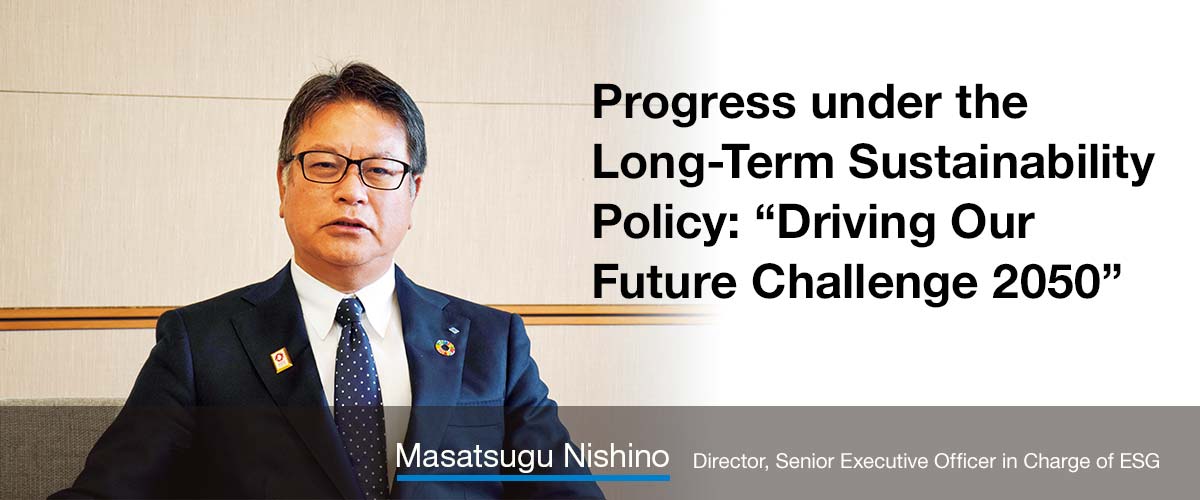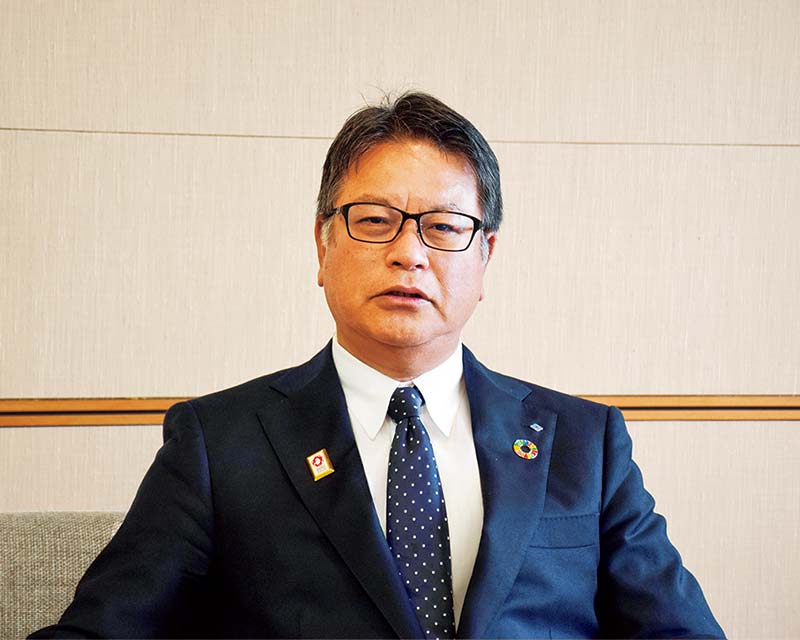A Message from the Director in Charge of ESG
Progress under the Long-Term Sustainability Policy: “Driving Our Future Challenge 2050”


Masatsugu NishinoDirector, Senior Executive Officer in Charge of ESG
Awareness of “Driving Our Future Challenge 2050” Is Being Steadily Entrenched among Our Workforce
It has been two years since we announced our Long-Term Sustainability Policy in conjunction with the financial results disclosure in August 2021. Following this announcement, we took a topdown approach to disseminating the policy that entailed reporting sessions for employees as well as one-on-one meetings between top management and the heads of each department. This was paired with a bottom-up approach wherein employees who had been tasked with formulating the policy were empowered to advocate for it at their respective Group companies or departments. As these efforts have helped raise sustainability literacy among employees, I feel that awareness of our Long-Term Sustainability Policy is steadily being entrenched in the workforce.
Moreover, indicators associated with ESG management have been incorporated into performance targets for officers, while the Shirakawa Factory initiated the utilization of hydrogen in tire manufacturing. As these and other tangible developments came into play after the announcement of our Long-Term Sustainability Policy, I am now acutely aware of the importance of setting long-term targets like this. In line with this policy, we are currently focused on the three initiatives named below to fully leverage our unique strengths.
First, we are promoting the utilization of hydrogen. This involves the switching over of fuel used in manufacturing processes from natural gas to hydrogen, with the aim of achieving carbon neutrality.
Second, we are working to increase the sustainable raw material content of our products. Such content is defined as biomass raw materials that are of biological origin and recycled raw materials. As of fiscal 2022, our products’ sustainable raw material content ratio was 33%. We plan to raise this to 40% by 2030. To this end, we are considering introducing carbon recycling and employing an even more diverse range of recycled raw materials. Technically, we will be able to achieve the target ratio ahead of schedule via current measures. However, there are some issues that must be addressed, including how to translate the resulting rise in costs into sales prices and whether increased costs could be offset by weight reductions.
Third, we are abiding by the certification system we established for sustainable products based on internal standards. Specifically, we have defined the assessment standards applied to all offerings in our Tire, Sports, Industrial Products businesses. These standards cover the ratio of sustainable raw materials used and the amount and type of energy consumed in the course of manufacturing. Under a two-grade system, we determine products deemed worthy of “Standard” or “Gold” certification based on the degree of their achievement relative to the above standards. Our current aim is to ensure that all products are certified “Standard” by 2030.

Realizing Japan’s First Carbon-Neutral (Scopes 1 and 2) Manufacturing Process for Mass-Production Tires
Among the three initiatives I discussed above, our greatest accomplishment has been in hydrogen utilization at factory lines.
The energy used in tire manufacturing comes from two sources: electric power and natural gas. With regard to electric power, we have reduced CO2 emissions arising from its use, with our measures to this end centered on the installation of energy-saving facilities, the expansion of cogeneration systems, the introduction of solar power generators and a shift to green energy procured from renewable energy sources. However, it is technically difficult to replace the steam used in the curing process, which forms tires by applying heat and pressure, with electricity. Thus, the energy transition of this process has long been an issue.
To resolve this issue, verification testing has been under way at our Shirakawa Factory in Shirakawa City, Fukushima Prefecture, as part of a project subsidized by the New Energy and Industrial Technology Development Organization (NEDO). This project aims to switch the fuel used to produce steam for curing from natural gas to hydrogen. In January 2023, this factory began supplying steam produced by hydrogen-fired boilers to the curing process of our leading-edge NEO-T01 Manufacturing System, which employs a high-precision metal core and enables the production of tires boasting extremely high performance with a compact, streamlined process.
Furthermore, the installation of solar panels has made it possible to obtain a robust output in excess of the volume of electricity used in NEO-T01 processes. As a result, our Shirakawa Factory has realized Japan’s first mass-production tires manufactured via a carbon neutral process as defined in terms of eliminating Scope 1 and 2 emissions.
Going forward, we will conduct verification testing to determine how to best control the NOx emission volume, a typical issue with hydrogen-fired boilers, as well as to identify and resolve various issues associated with the around-the-clock operation. In this way, we will assess the effectiveness of the switchover to hydrogen fuel.
In general, the switchover to hydrogen fuel entails only the replacement of boilers or turbines and does not require changes in other manufacturing facilities. This is one of the great advantages of hydrogen utilization. Our Shirakawa Factory currently aims to expand the scope of hydrogen utilization to encompass all of its manufacturing lines. Once the use of hydrogen is widespread among our domestic factories, we will strive to roll it out at our overseas factories.
Also, we are considering the procurement of carbon-free, green hydrogen. Moreover, in line with our aim to develop a manufacturing model featuring the local consumption of locally produced hydrogen, we use hydrogen supplied by a corporation based in Fukushima Prefecture.
Formulating the Sumitomo Rubber Group’s Unique Business Concept Supporting a Circular Economy
The Sumitomo Rubber Group has announced “TOWANOWA,” a unique business concept designed to support the circular economy through our Tire business. Today, the realization of a circular economy is a matter of urgency. In response, this business concept aims to help develop a circular economy in a way that takes full advantage of the Sumitomo Rubber Group’s unique capabilities. Specifically, “TOWANOWA” connects the “Sustainable Ring,” which is the efficient circulation of goods and the recycling of resources within five key processes of our Tire business, and the “Data Ring,” which is the consolidation and sharing via the cloud of data gleaned from the above five processes using our SENSING CORE Technology.
In Japan’s tire industry, circular economy-related initiatives have mainly focused on thermal recycling, which utilizes waste tires as fuel to obtain heat. As a result, thermal recycling accounts for around 70% of tire reuse while recycling by retreading accounts for only about 6%.
In contrast, “TOWANOWA” employs an unconventional approach linking tire data gleaned from vehicles as they are being driven via the use of our unique sensing technologies with production data to create a combined source of data that informs each of the five Tire Business processes while providing end users with feedback based on such data. These are the distinctive features that set this business concept apart.
Challenges That Must Be Overcome to Further Promote ESG Management
Tasked with spearheading ESG management, the Sustainability Promotion Committee holds meetings twice a year attended by the Group President and all officers. These meetings focus on conducting a global management review and sharing information among bases. Meanwhile, meetings of personnel in charge of promoting sustainability are also convened to discuss specific measures to be implemented. Among the 48 participants who currently attend these meetings are the project members who led the formulation of our Long-Term Sustainability Policy. In 2023, we increased the frequency of these meetings from a quarterly basis to six times per year. Going forward, we intend to expand the number of meeting attendees and invigorate discussions.
As explained above, the Sumitomo Rubber Group places great emphasis on ensuring that all of those in top management have an in-depth understanding of ESG management and take the lead in promoting it. This emphasis is also appreciated by external specialists as a positive factor that makes it easier for our group to promote ESG.
As an executive in charge of ESG, I have formulated a policy of making the Sustainability Promotion HQ attractive to employees over the long term. The Sumitomo Rubber Group is currently promoting in-house postings to sustainability-related projects, which can involve environmental management, diversity & inclusion and other relevant operations. Employees who participate in these projects are steadily raising their abilities to apply a sustainability perspective when undertaking their principal duties. I personally expect that individuals who have gained such experience will take the lead in practicing ESG management at each department.
In order to expand the scope of sustainability initiatives, we need to encourage as many employees as possible to develop a sense of ownership regarding the implementation of relevant measures. The process of developing a sense of ownership is believed to consist of four stages: (1) Recognition, (2) Understanding, (3) Application and (4) Contribution. However, some employees may face challenges that inhibit them from developing a sufficiently tangible sense of ownership and reaching the fourth stage of contributing to sustainability through their own operations. With this in mind, we will initiate this process by disseminating information on initiatives undertaken by the Sumitomo Rubber Group among a broad range of employees. We also intend to develop a framework for supporting ongoing communication with them.
Sustainability initiatives will yield tangible effects only when they are implemented over the long term. Although some of our initiatives are likely to result in cost increases, we will carefully judge whether they can be sustainably implemented even as we give due consideration to their impact on operating results. This is another challenge that must be overcome. To address this challenge, we aim to secure an even more robust structure capable of enabling both business divisions and top management to engage in thorough discussions to reach the best decision for the corporation.